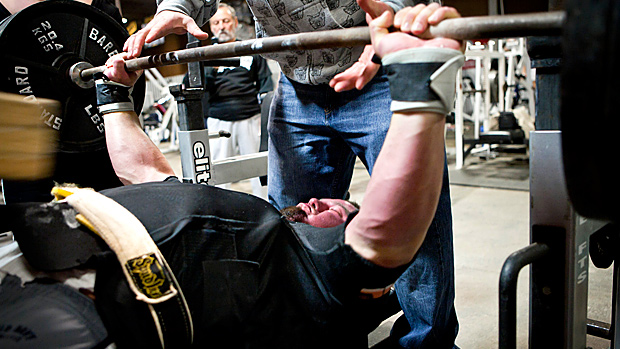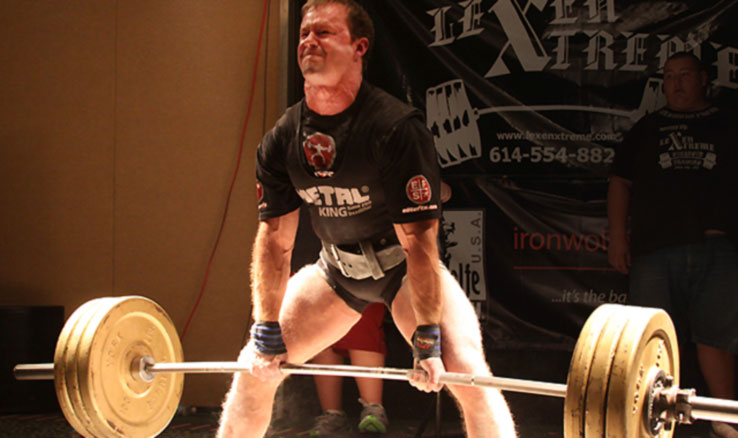The biceps curl is a basic exercise that everybody is familiar with, but many lifters don't know how to do them as well as they think. These three tips will help you get the most gains from curls.
Mechanical tension is the main mechanism behind muscle hypertrophy (growth) and strength gains are joint-angle specific. So, maximizing mechanical tension throughout the entire range of your curl is essential to getting the most out of each rep. These three tips are meant to do exactly that. At the end, we'll also cover some misconceptions about cheating and what research says about it.
Before you can perform any exercise properly you have to get set up correctly. For a standing curl, you want a tall posture, arms extended by your side, and about a shoulder-width grip on the bar. But a commonly overlooked aspect of proper setup is foot placement.
Most people keep their feet side by side, which creates a small base of support in the sagittal plane (front to back). That's a problem because the curl is performed in this plane. And when the barbell moves in front of you as you curl it, it causes your center of mass to shift forward.
To adjust for that, you have to lean back to keep from falling forward, especially if you're going heavy. That's all fine, but when you string a few reps together it forces you to swing the bar up and down, reducing muscular participation.
So instead of keeping your feet side by side, stagger them just a little bit, distributing your weight evenly.

This provides a bigger base of support in the sagittal plane that allows you to counterbalance your center of mass moving back and forth. Now you don't have to lean back and can maintain your posture.
It doesn't take a lot of stagger for this to work. Placing one foot just in front of the other, heel to toe, should be plenty. More stagger isn't always better though. It can become distracting and difficult to keep your posture and balance in the frontal plane (side to side).
Placing the toe of your front foot in line with the bar when your elbow is flexed to 90 degrees should be sufficient to make sure your center of mass will always be within your base of support.
Probably the biggest mistake people make is letting their elbows shift forward as they curl the bar up. All they're concerned with is moving the bar from point A to point B. This can reduce and even completely remove the resistance to the biceps, which in turn will diminish mechanical tension – a prime driver to building muscle.
Think less about lifting the weight up. Instead think about simply bending your elbows as much as you can and then fully extending them. This will take away the desire to move the bar from point A to point B and allow your biceps to do the work throughout the entire range.

Another cue that will help is to squeeze the bar into your body once you get the bar about half to three-quarters way up. Your hands should start to move more and more toward your body throughout the range of the curl. You shouldn't be thinking about moving the bar up at all. Instead squeeze your biceps to move the bar towards you.
Here's why tips one and two are so important. The biceps curl is essentially all about maintaining torque around the elbow that the biceps has to fight against. This ensures that there will always be mechanical tension to the targeted muscles. Good for the gains!
Torque is really what we're talking about when we use the term "resistance." We move around axis which we call joints. It's a product of force and distance, and in this case we're talking about the weight in your hand (force) and a moment arm – the shortest distance between the line of force and axis.
To make sure there's always resistance (torque) that your biceps has to work against, the line of force from the bar must always remain anterior to your elbow. Once the line of force either lines up with the elbow joint or passes posteriorly to it, the moment arm relative to the biceps is gone and all resistance and mechanical tension is lost. Not so good for the gains. The biceps curl is really all about keeping the line of force anterior to the elbow to preserve mechanical tension.
Many people get the bar to the top of the curl and think the exercise is over. They just let the bar fall back down to the starting point. However, bending your elbows and squeezing the bar into your body is only half of the rep. You still have work to do: returning the bar to the starting position. Remember in tip two where I said "bend and extend?" This is the extend portion.
A great cue for properly performing the lowering portion is to pretend there's a pane of glass that you're going to set the bar on. You have to set it down softly so the glass doesn't break. It demands that you use your muscles to control the weight back down, thus maintaining mechanical tension throughout the entire curl.
Not only does letting the bar fall back down take away mechanical tension from the biceps, it also increases the risk of injury. The faster a weight moves, the more momentum it has. The more momentum it has, the more impulsive force is needed to stop it. An impulsive force is simply a large force placed on an object over a short period of time. It's like dropping a five pound weight on your toe versus gently setting it on your toe.
Tips two and three can be used for all variations of biceps curls, such as cable curls and seated incline curls.
Look around your gym and you'll probably see at least a few people using poor form on the curl, yet still possessing a great set of biceps. Why? Research shows that use of moderate momentum (cheating) increases the torque of the target muscles even without an increase in the weight used. That moderate increase in the load and the use of momentum allows the torque to be increased even further.
While excessive use of momentum results in lower demands on the target muscles, an excessive increase of the load reduces the total hypertrophy stimulus by virtue of the decreased number of reps which can be performed successfully and thus dramatically shortened time under tension.
So does that mean cheating is good for growth? Well, mechanical tension is still present during cheat reps. However, this doesn't mean that cheating with momentum is just as effective as not cheating by avoiding momentum.
Cheating is only applying mechanical tension in PART of the range of motion, and using momentum to get through the rest of the range. So, although cheating may still have you moving through the full range of motion, from a mechanical tension perspective, it's essentially a partial rep.
Remember, strength gains are joint-angle specific so your muscles will only get stronger in the ranges in which they're challenged. Additionally, partial range of motion reps creates less muscle growth than full range of motion reps.
So, most of your reps should be full range with no cheating, though one or two "bonus" reps at the end with a controlled cheat does extend the time under tension. Just make sure all your reps aren't cheat reps, bro.
- Bloomquist K et al. Effect of range of motion in heavy load squatting on muscle and tendon adaptations. Eur J Appl Physiol. 2013 Aug;113(8):2133-42. PubMed.
- Arandjelović O. Does cheating pay: the role of externally supplied momentum on muscular force in resistance exercise. Eur J Appl Physiol. 2013 Jan;113(1):135-45. PubMed.
- Pinto RS et al. Effect of range of motion on muscle strength and thickness. J Strength Cond Res. 2012 Aug;26(8):2140-5. PubMed.



